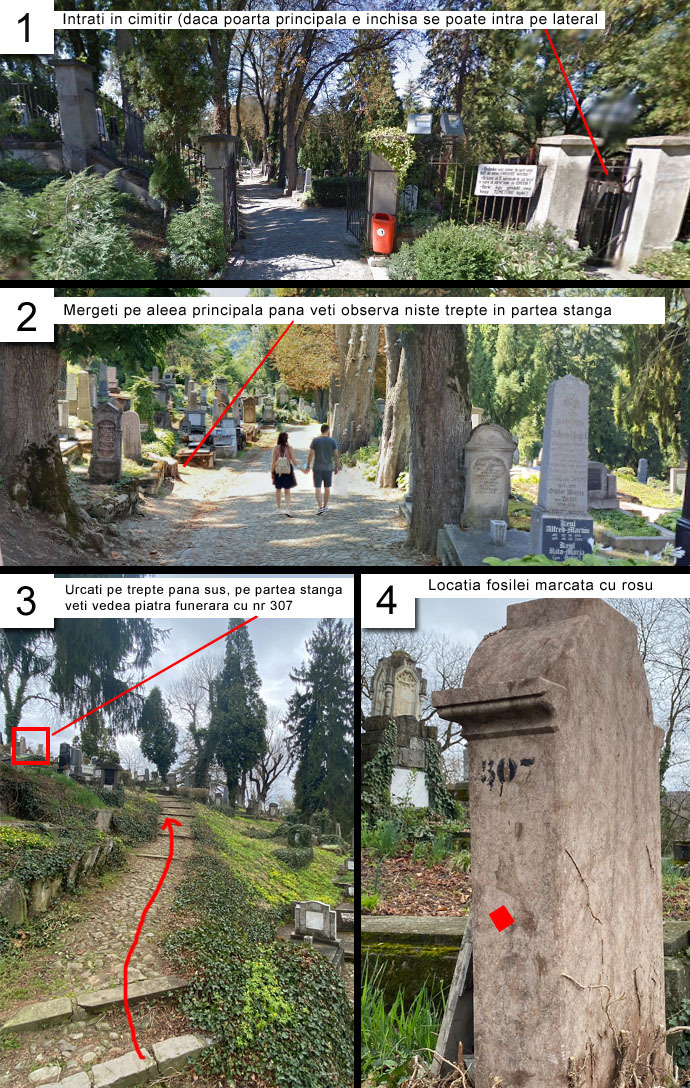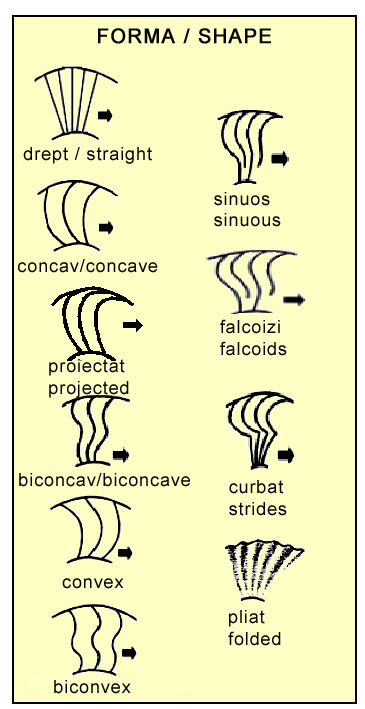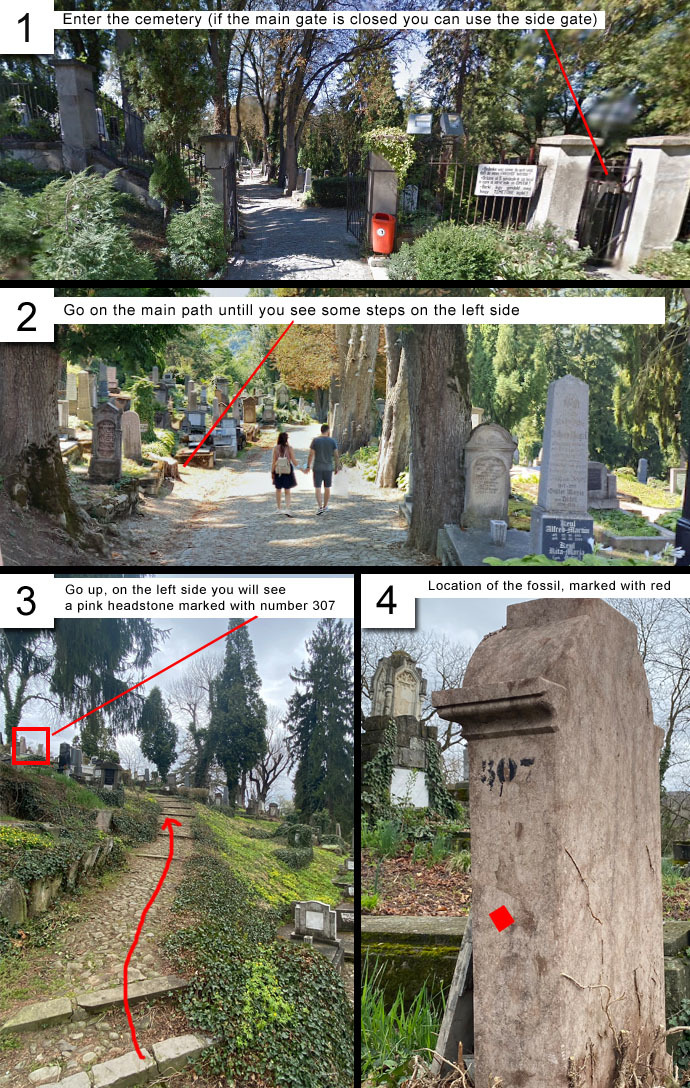 Română
Română
Cimitirul Bisericii din Deal (Cimitirul bisericii evanghelice)
Cimitirul Sasilor (denumirea cunoscuta printre localnici) este un cimitir din secolul al XVIII-lea, un loc in care se odihnesc mai multi sasi decat au ramas astazi in vechiul tinut sasesc. Odata cu trecerea timpului si cu regresul comunitatii sasesti, cimitirul a inceput sa gazduiasca pe veci si locuitori de nationalitate romana. In acest loc un calator poate gasi o oaza de liniste, un loc ideal de meditatie si de observatie a micilor vietati care si-au gasit aici casa: mierle, melci, ciocanitori sau chiar si veverite.
Pietrele funerare roz
Din momentul in care pasesiti in cimitir veti observa ca anumite pietre funerare sunt mai deschise la culoare, roz-albe. Acest tip de roca, pe langa rolul lor funerar, adapostesc si organisme vechi ce au trait pe Pamant in urma cu milioane de ani. Pentru acest EarthCache am ales o fosila ce poate fi gasita foarte usor urmarind pasii de mai jos:

Fosila pe care o veti observa este un amonit, un grup de moluște cefalopode dispărute acum, care au trăit în urma cu aproximativ 400 de milioane de ani fără a lăsa descendenți cunoscuți. Acestea erau animale marine, caracterizate printr-o cochilie externă compusă în principal din carbonat de calciu și parțial dintr-o substanță organică de natură proteică (conchiolina). Cochilia a fost împărțită intern de septe în camere diferite, dintre care molusca ocupa doar ultima (camera de locuit). Celelalte, care alcătuiau fragmocono-ul (partea camerei a carcasei), au fost folosite ca și „camere de aer” (asemănătoare cu actualul Nautilus), umplute cu gaz și lichid pentru a controla flotabilitatea organismului.
Presiunea fluidelor camerei era controlată de o structură organică tubulară subțire, bogat vascularizată, parțial mineralizată, (sifonul), care traversa toate septurile și permitea schimbul de fluide din sângele și țesuturile moi ale animalului către camere printr-un proces de osmoză. Astfel, amonitul isi putea varia adâncimea (în limitele rezistenței mecanice ale carcasei) într-un mod similar cu nautiloidele încă vii.
Probabil că amoniții, la fel ca toate cefalopodele cunoscute, erau organisme carnivore și, conform studiilor disponibile, probabil că au dezvoltat un număr mare de adaptări diferite, de la prădarea activă a animalelor marine, la microfagia (pradarea microorganismelor), la necrofagia (consumul de carne). a organismelor moarte) și chiar canibalism (pradarea altor amoniți, inclusiv a celor conspecifici).
 EarthCache
EarthCache
1. Atingeti piatra. Ce textura are?
2. Care este diametrul aproximativ al fosilei marcate cu rosu?
3. Determinati forma fosilei folosind reperele de mai jos:
4. Atasati o poza a unei alte pietre funerare care v-a placut (nu atasati poze cu piatra funerara sau fosila mentionate in acest EarthCache)
Log-urile fara poze vor fi sterse!

 English
English
Evangelical church cemetery
The Saxon Cemetery (the name known among the locals) is an 18th century cemetery, a place where more Saxons rest than are left today in the old Saxon land. As the years passed and the Saxon community declined, the cemetery began to host even Romanian residents. In this place a traveler can find an oasis of peace, an ideal place for meditation and observation of the little creatures that have found their home here: blackbirds, snails, woodpeckers or even squirrels.
The pink tombstones
From the moment you walk into the cemetery you will notice that some tombstones are lighter in color, pink-white. This type of rock, in addition to their funerary role, is also home to ancient organisms that lived on Earth millions of years ago. For this EarthCache I picked a fossil that can be found easily, following the steps below:

The fossil you will see is called an ammonite, part of a group of extinct cephalopod molluscs, which appeared 400 million years ago without leaving any known descendants. These were marine animals, characterized by an external shell composed mainly of calcium carbonate, in the form of aragonite, and partly of an organic substance of a protein nature (conchiolin) . The shell was internally divided by septa into different chambers, of which the mollusk occupied only the last (dwelling chamber). The others, which made up the fragmocono (chambered part of the shell), were used as "air chambers" (similar to the current Nautilus), filled with gas and chamber liquid to control the buoyancy of the organism. The pressure of the chamber fluids was controlled by a thin, richly vascularized, partly mineralized, tubular organic structure (the siphon), which crossed all the septa and allowed the exchange of fluids from the blood and soft tissues of the animal to the chambers through a process of osmosis. The ammonite could thus vary its depth (within the mechanical strength limits of the shell) in a similar way to the still living nautiloids.
Probably the ammonites, like all known cephalopods, were carnivorous organisms, and according to the available studies they probably developed a large number of different adaptations, from active predation of marine animals, to microfagia (predation of microorganisms), to necrophagia (consumption of meat of dead organisms), and even cannibalism (predation of other ammonites, including conspecific ones).
 EarthCache
EarthCache
1. Touch the stone. What does it feel like?
2. What is the size of the fossil marked with red?
3. Based on the following image, try to determine the shape of the fossil/s.
4. Attach a photo of another tombstone that you liked (please do not attach photos of EarthCache tombstone or fossil)
Logs without attached photo will be deleted!
